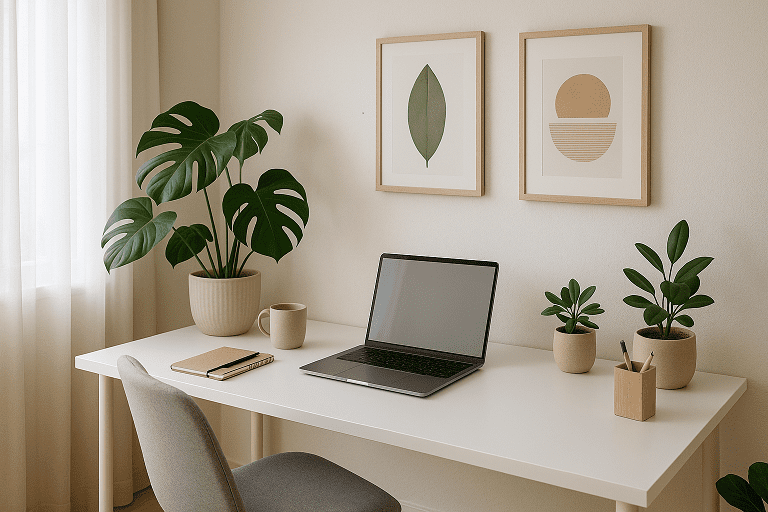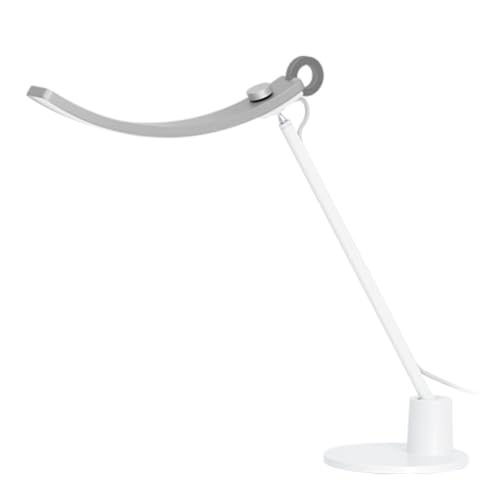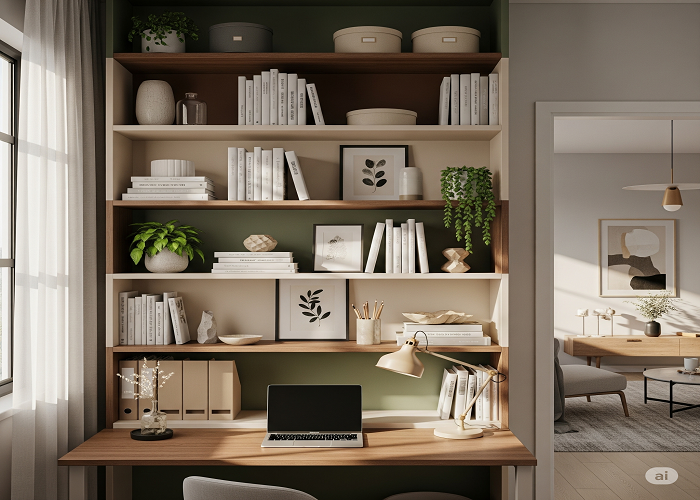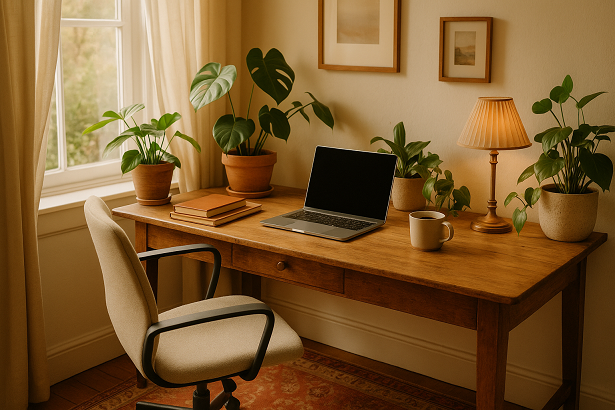
Powerful Home Office Designs for a Stylish, Productive Space
Affiliate Disclosure: As an Amazon Associate, we may earn from qualifying purchases. This helps support HushDesk at no extra cost to you.
Readers’ Guide
In an era where the boundaries between home and work have significantly blurred, the importance of home office designs has never been more pronounced. What used to be a temporary workspace tucked into a corner of a living room has evolved into a vital part of modern living—a place where productivity, comfort, and personal identity must co-exist seamlessly.
Designing a home office isn’t just about aesthetics. It’s about engineering a space that reflects your purpose and propels you forward, whether you’re grinding through Zoom calls, writing marketing copy, or crafting designs deep into the night. The right design doesn’t just make a room look beautiful—it fuels focus, supports posture, and inspires creativity.
My journey with home office designs began when I ditched the traditional desk-and-chair combo in favor of an intentionally curated space that mirrored my goals and passions. The result? I felt more in control of my day, more energized to tackle demanding projects, and more at peace with my environment. And I’m not alone—countless remote workers have discovered that the secret to peak performance often begins with the room they work in.
In this guide, we’ll explore what makes a home office truly functional and stylish, how to design for small spaces, how to work with a budget, and which modern trends are reshaping how we perceive workspaces in 2025. We’ll even dive into color psychology, product recommendations, and smart ways to keep your setup clutter-free.
If you’ve been wondering how to upgrade your work-from-home experience—or you’re just starting to build your ideal office from scratch—then you’re in the right place. Let’s uncover how thoughtful home office designs can elevate not just your space, but your entire work-life dynamic.
The Psychology of a Well-Designed Home Office
A beautifully designed home office is more than just an Instagram-worthy backdrop—it is a psychological tool that can either enhance or hinder your performance. The best home office designs are built on more than color palettes and furniture choices; they are grounded in the science of how our surroundings influence the way we think, feel, and behave.
Let’s start with color. Cool tones like blue and green are proven to reduce stress and improve concentration, while warm neutrals like beige and light gray foster a sense of calm and balance. On the flip side, clutter and chaos—visually or physically—can lead to anxiety, procrastination, and decision fatigue. This is why clean lines, tidy workstations, and minimalist layouts aren’t just a matter of taste—they’re a matter of mental well-being.
Lighting also plays a critical role. Natural light has been shown to boost mood and regulate sleep cycles, which are essential for sustained focus. When natural light isn’t available, adjustable LED lighting that mimics daylight can help maintain alertness and reduce eye strain during long work sessions.
Spatial arrangement is equally important. The layout of your office should promote movement and flow. Being physically boxed in or sitting in awkward positions can drain your energy and even trigger subconscious stress responses. When your environment feels open and balanced, your brain gets the signal that it’s safe to focus and perform.
In essence, a well-designed office space is like a silent business partner—always working in the background to elevate your productivity, creativity, and peace of mind.
Essential Elements of Functional Home Office Designs
While the aesthetics of a workspace draw attention, it is functionality that sustains long-term productivity. The best home office designs balance visual appeal with essential features that support the way you work—physically, mentally, and professionally.
Ergonomic Furniture Is Non-Negotiable
If you spend hours at your desk, investing in ergonomic furniture isn’t a luxury—it’s a necessity. Start with the chair. A high-quality ergonomic chair with lumbar support, adjustable height, and breathable fabric can significantly reduce fatigue and the risk of back pain. Pair it with a desk that suits your workflow. Whether you prefer a minimalist writing desk or a height-adjustable standing desk, ensure that your table provides enough surface area without overwhelming the space.
Layout: It’s All About Flow
The layout of your home office should allow for ease of movement and encourage productivity. Ideally, your desk should face a window or a blank wall—both options help reduce distractions. Keep your most-used tools (laptop, notepad, pens, headset) within arm’s reach to minimize unnecessary movement. Position your monitor at eye level to reduce neck strain, and if you’re using dual monitors, align them symmetrically to maintain visual balance.
Smart Lighting Makes a Difference
Lighting is often overlooked but critical. If you have access to natural light, take advantage of it by placing your desk near a window. For evening or low-light conditions, invest in a quality LED desk lamp with brightness control and color temperature settings. Warm white lighting is relaxing, while cool white light boosts alertness—choose based on your workload and time of day.
Noise Control for Deep Focus
Distractions kill momentum. If you’re working in a shared household or a busy environment, consider acoustic panels, thick rugs, or noise-canceling headphones to block out background noise. Even something as simple as a white noise machine can provide the sensory isolation needed for deep focus.
Decor That Inspires, Not Distracts
Wall art, indoor plants, and personal mementos can make your office feel uniquely yours, but be careful not to overcrowd your space. A few well-chosen pieces can inspire creativity and make your environment feel less clinical—without turning it into a visual distraction.
In short, functional home office designs are not created by chance. They’re curated intentionally, blending ergonomic features, smart layout decisions, and psychological cues that allow you to perform at your best—day in and day out.
Modern Home Office Design Trends in 2025
Home office designs in 2025 are more than just a collection of furniture and gadgets—they are a reflection of evolving work cultures, wellness priorities, and a deepening appreciation for personal space. The modern home office is adaptable, stylish, and smart—merging innovation with intention.
Minimalism Meets Functionality
Minimalism continues to dominate, not just for its aesthetic appeal but for its practical benefits. A clutter-free environment fosters mental clarity. In 2025, we’re seeing a surge in clean-lined furniture with hidden storage compartments, floating desks, and neutral color palettes that create a calming atmosphere. Think white walls, light wood tones, matte black accents, and seamless cabinetry. This trend emphasizes “less, but better”—a principle that eliminates distractions and highlights what matters most.
Tech-Integrated Workspaces
The rise of smart home technology has naturally extended into home office designs. Wireless charging pads built into desks, voice-controlled lighting, smart thermostats, and adjustable standing desks that remember your preferred height settings are becoming commonplace. Even ergonomic chairs are now designed with embedded sensors to remind you to improve posture or take breaks. These smart solutions are no longer futuristic—they are expected.
Biophilic and Nature-Inspired Elements
With remote work becoming permanent for many, designers are infusing home offices with elements of nature to reduce stress and enhance focus. Biophilic design—a trend rooted in our innate connection to nature—brings the outdoors inside through houseplants, natural textures, stone accents, and large windows that welcome daylight. The goal? Create a space that breathes with you.
Hybrid Work Zones
Gone are the days of one-size-fits-all workspaces. The modern home office is modular and multifunctional. Convertible furniture, such as fold-out desks or chairs that double as storage units, makes it easier to transition between focused work, collaborative Zoom meetings, and creative brainstorming sessions. Some homeowners are even dividing their spaces into “focus zones” and “creative corners” for better task management.
Aesthetics That Express Identity
Today’s professionals crave a workspace that feels personal. Whether it’s a wall gallery of travel photos, a curated shelf of books and awards, or a color scheme that reflects your personality—customization is in. Modern home office designs are no longer generic—they’re intimate. They tell your story.
These design trends reveal a clear shift: from rigid office formality to warm, wellness-focused, and deeply personalized spaces. If you’re looking to update your setup, these ideas offer inspiration that blends both beauty and brainpower.
Designing for Small Spaces: Smart Home Office Ideas
Not everyone has the luxury of a spare room, but that shouldn’t stop you from building a high-performance, visually appealing workspace. In fact, some of the most inspiring home office designs come from tight spaces that embrace creativity and functionality in equal measure. With the right strategies, even a small corner can become your productivity sanctuary.
Vertical Space Is Your Secret Weapon
When horizontal room is limited, think vertically. Wall-mounted shelves, pegboards, and floating desks can dramatically increase usable space without adding clutter. A vertical file sorter, for instance, can hold documents without consuming valuable desk real estate. Pegboards above your desk keep tools and accessories visible yet organized, freeing your surface for actual work.
Foldable and Multi-Functional Furniture
Look for furniture that adapts to your lifestyle. Fold-down wall desks are ideal for those working in studio apartments or shared living areas. They can be closed up when not in use, instantly restoring space. Similarly, ottomans that double as storage, or desks with drawers and compartments, allow you to pack more function into less footprint.
Choose Light Colors and Open Forms
Light color palettes—whites, soft grays, and pastels—create an illusion of openness. Opt for furniture with open frames or glass surfaces to prevent visual crowding. Avoid bulky furniture that dominates the space; instead, go for minimalist pieces that add form without sacrificing style.
Dual-Purpose Zones
If you’re working from a bedroom, dining area, or hallway, divide your zones with intention. A small area rug or a backdrop (like a foldable screen or bookshelf divider) can visually distinguish your workspace from the rest of the room, helping you mentally “enter” and “exit” work mode.
Small-space home office designs thrive on innovation. When done right, they deliver all the function of a full-sized office without compromising on beauty or utility. It’s not about how much space you have—it’s about how smartly you use it.
DIY Home Office Design: How to Set Up on a Budget
A well-designed home office doesn’t have to break the bank. With a little creativity, resourcefulness, and intention, you can build a functional and aesthetically pleasing workspace that supports your productivity—without overspending. In fact, some of the most character-filled home office designs are DIY projects born from necessity and fueled by personal flair.
Start with What You Have
Before rushing to buy new items, take inventory of what you already own. That unused bookshelf in the living room? It could become your document station. The spare dining chair? With a cushion and lumbar support, it can serve as a temporary desk chair until you upgrade. Repurposing furniture not only saves money but also adds a sense of uniqueness to your space.
Build Your Own Desk
If you’re handy—or even semi-handy—you can build a custom desk using affordable materials like plywood, metal piping, or repurposed wood. Simple wall-mounted desktop slabs with L-brackets create an airy, modern look while keeping costs low. You can also convert a sturdy console table or vanity into a desk, optimizing small spaces.
Use Thrift Stores and Online Marketplaces
Facebook Marketplace, Craigslist, and local thrift shops are treasure troves for budget-friendly furniture and décor. From vintage desks to mid-century lamps, you can score quality pieces at a fraction of retail prices. Don’t shy away from items that need a little TLC—a fresh coat of paint or new knobs can completely transform a dated piece.
DIY Décor with Personality
Incorporate personal artwork, framed quotes, or printed calendars as budget-friendly wall décor. Use mason jars or repurposed tins to hold pens, paperclips, and other supplies. A corkboard made from inexpensive foam board and fabric can become your idea wall or vision board.
Lighting on a Dime
Even lighting can be tackled creatively. Clip-on lamps or battery-powered LED strips can provide targeted illumination. Natural light remains your best (and free) friend, so place your desk near a window if possible.
Great home office designs don’t require deep pockets—just vision, consistency, and a touch of ingenuity. With thoughtful planning, you can build a space that looks professional, feels personal, and performs exceptionally.
Best Colors for a Home Office and Why They Matter
Color is more than decoration—it’s a psychological tool that can elevate your focus, mood, and creativity. In effective home office designs, the right color palette enhances the way you think and feel, subtly influencing your productivity and emotional state.
Blue: The Color of Focus and Calm
Blue is a top choice for high-focus work environments. It promotes mental clarity, reduces stress, and supports deep concentration. Lighter blues are ideal for calm, thoughtful work, while navy adds a sophisticated, grounding effect.
Green: Balance and Restoration
Green evokes balance, harmony, and renewal. It’s especially beneficial for those who spend long hours in the office, as it reduces eye strain and offers a sense of natural serenity. A soft sage or muted forest green can bring warmth without distraction.
White and Gray: Clean, Neutral Foundations
White and gray are versatile base colors that support other accents. White reflects light and makes small spaces feel bigger, while gray adds a mature, modern vibe. These tones are perfect for minimalist and modern home office designs.
Color Pairings Based on Work Style
- Creative work: Soft greens and warm neutrals
- Analytical tasks: Blues and cool grays
- Client-facing roles: Muted tones with pops of inviting color (like terracotta or mustard)
In short, the best home office colors are those that align with your goals—and your personality.
Organizing Your Home Office for Peak Productivity
A well-organized home office does more than just look tidy—it empowers efficiency, reduces mental clutter, and reinforces discipline. In fact, even the most stunning home office designs can fall short if clutter creeps in. The key to staying productive lies in creating systems that are intuitive, sustainable, and tailored to your workflow.
Establish Zones Within Your Space
Divide your workspace into zones based on function. Your primary work zone—where your desk, laptop, and essential tools live—should be clutter-free and ergonomically arranged. A secondary storage zone can house less frequently used items like files, printers, or office supplies. If space allows, add a small reading or brainstorming corner to stimulate creativity without disturbing your main workflow.
Go Paperless—Or Close to It
Minimize physical clutter by digitizing documents whenever possible. Use cloud storage platforms like Google Drive or Dropbox to store contracts, notes, and reference materials. Invest in a small scanner or use mobile apps to digitize paperwork and receipts. Reducing paper not only saves space but also streamlines your workflow.
Utilize Vertical Storage
Walls are often underused real estate in a home office. Wall-mounted file holders, pegboards, floating shelves, and magnetic boards can store everything from books to accessories. This keeps your desk surface open for focused tasks while keeping everything within reach.
Keep Daily Tools Accessible, Not Obtrusive
Use drawer organizers, desktop trays, or minimalist desk caddies to hold pens, sticky notes, chargers, and other daily tools. The goal is to have everything you need visible and within reach—but not visually overwhelming.
Declutter Regularly
Set aside five minutes at the end of each workday to reset your workspace. This habit maintains order, clears your mental space, and sets a tone of professionalism—even at home.
Ultimately, good organization is about intention. By giving every item a purposeful place, your home office design becomes not only efficient, but empowering.
Product Recommendations for the Ideal Home Office Setup
Building a functional and stylish home office goes beyond design—it’s about choosing the right tools that support your work habits while complementing your aesthetic. Here, we present top-rated Amazon product recommendations that align with modern home office designs, combining form, function, and affordability. These aren’t just products—they’re productivity partners.
1. SIAGO Electric – Adjustable Standing Desk
- Rock-solid Stability : Featured 19.8cu.in. larger connection area (at full height) with 1.5mm commercial-grade frame, SI…
- Reliable&Durable : This electric standing desk lifting power enough to fully loaded office and game equipment up to 200l…
- Adjustable Height Desk : Effortlessly transition from sitting to standing with just the touch of a button (27.95″ to 45….
This electric standing desk offers height adjustability with memory presets, making it ideal for alternating between sitting and standing. Its sleek design complements minimalist aesthetics while encouraging better posture and circulation.
Why It’s Ideal:
Promotes ergonomic health, supports heavy equipment, and integrates seamlessly with modern decor.
2. Herman Miller Aeron Ergonomic Chair
- Recycled Material
- Your purchase includes One Herman Miller Aeron Ergonomic Chair – Size B, graphite color
- Chair dimensions: 41″ H x 27″ W x 16.75″ D. Seat heights: 16”-20.5”.
A cult-favorite among professionals, the Aeron chair provides unmatched lumbar support, breathable mesh, and customizable tilt options.
Why It’s Ideal:
Long-term comfort for extended work sessions. Great for people with back issues or posture concerns.
3. BenQ e-Reading LED Desk Lamp
- 💡【ULTRAWIDE ILLUMINATION】: BenQ e-Reading Desk Lamp utilizes OVAL-Light technology to illuminate a 35.4″ x 26.7″ (90cm x…
- 💡【2 SMART-DIMMING MODES】: Our Smart LED desk lamp uses a built-in ambient light sensor to automatically adjust the deskt…
- 💡【CUSTOMIZABLE COLORS & BRIGHTNESS】: In addition to two smart dimming modes, this lamp also offers manual adjustment fun…
Unlike standard desk lamps, the BenQ lamp offers wide-angle lighting, automatic brightness adjustment, and color temperature control—ideal for long reading or computer hours.
Why It’s Ideal:
Reduces eye strain, especially in low-light conditions; its futuristic design enhances modern setups.
4. SimpleHouseware Mesh Desk Organizer Set
- Vertical Sections for File Storage – Upright compartments keep folders and file holders neatly arranged and easy to acce…
- Horizontal Letter Trays – Offers space for storing folders, notebooks, scissors, staplers, and other desk accessories.
- Drawer with Adjustable Compartments – Includes three sections and six movable dividers for organizing pens, markers, and…
This elegant black mesh organizer keeps your stationery, files, and accessories in order without cluttering your desk.
Why It’s Ideal:
Maximizes productivity by minimizing distraction. Fits beautifully in minimalist or contemporary layouts.
5. Cinati 2 Pack Cable Management Tray Under Desk
- Optimized Cable Management – The unique C-shaped design of CINATI cable management neatly conceals all power cords, data…
- Large Capacity Management: The generously sized cable management under desk measures 16″x5″x6″ (expandable to 32″ when i…
- Premium Metal Construction – Engineered with high-quality metal, our cable management trays support up to 11 lbs without…
Tame unruly cords with this under-desk tray. Easy to install and ideal for maintaining a clean, distraction-free environment.
Why It’s Ideal:
Organizes cables discreetly, enhancing safety and aesthetics. Essential for neat-freaks and creatives alike.
6. Mind Reader Rolling Storage Cart
- 100% Metal
- Multipurpose office storage: Great for organizing printers, files, supplies, and tech accessories in any office or home …
- Three-tier design: Durable MDF shelves provide ample vertical storage without taking up valuable floor space
Perfect for small-space home office designs, this mobile cart holds supplies, files, or even a printer. Easily rolls away when not in use.
Why It’s Ideal:
Mobile, compact, and multifunctional—a perfect blend of utility and style.
These product picks are more than recommendations—they’re solutions. Each one supports a specific aspect of an effective home workspace, whether it’s ergonomics, organization, lighting, or layout flexibility. When integrated thoughtfully, they elevate your home office design from functional to phenomenal.
For more on office design guide visit our homepage.
Conclusion: Designing a Home Office That Works for You
Creating a beautiful, functional home office is more than an aesthetic project—it’s a personal investment in your productivity, mental clarity, and long-term well-being. As remote work becomes the norm, the importance of intentional home office designs cannot be overstated. Whether you’re working with a dedicated room or just a quiet corner, your space should inspire you to focus, create, and thrive.
Start with the basics—comfort, lighting, and layout. Then, personalize. Let your workspace reflect your values and workflow. Choose colors that lift your mood. Organize for efficiency. Invest in products that support your goals, not just fill space. Ultimately, the best home office is the one that empowers your daily rhythm and uplifts your professional presence.
You don’t need a massive budget to create impact. With smart choices, creativity, and a bit of guidance, anyone can craft a space that is both beautiful and deeply functional.
Frequently Asked Questions
What are the best colors for a home office?
Blue, green, white, and gray are excellent choices. Blue promotes focus, green balances energy, and white and gray provide a clean, neutral backdrop.
How can I design a home office on a budget?
Repurpose existing furniture, use thrifted items, and incorporate DIY décor. Opt for affordable solutions like adjustable standing desks or multifunctional furniture.
What furniture is essential for a home office?
An ergonomic chair, a sturdy desk, and good lighting are key essentials. Organizing tools like shelves or file holders also improve efficiency.
How can I organize my home office?
Create designated zones, minimize paper, use vertical storage, and keep daily tools accessible but tidy. Regularly declutter to maintain a productive space.
Can I design a home office in a small space?
Yes! Utilize vertical storage, foldable furniture, and light colors to maximize space. Smart design and organization are key to small-space success.









